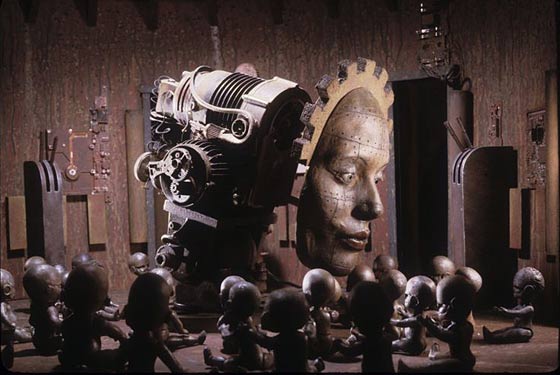4.3. Living in Contemporary Society
The reason why Durkheim, Marx and Weber are still read by sociologists is that they provided key insights into the formation of modern society that remain relevant today. Nevertheless, life in modern society is subject to constant change. How can Durkheim’s, Marx’s, and Weber’s analyses be updated to describe the key features of 21st century life?
Updating Durkheim: Postmodern Society and Neo-Tribalism
Durkheim predicted that there would be periods of anomie — normlessness, or a lack of common norms — as the small, isolated societies of mechanical solidarity were replaced by modern mass societies of organic solidarity. In the absence of a collective conscience and shared rituals, the complex division of labour in society would lead it to become increasingly divergent, heterogeneous and atomized. However, this anomie would be short-lived and temporary as the complex division of labour of organic societies stabilized. Eventually societies would emerge as cohesive, self-regulating systems of interdependent components and a new basis of social solidarity and social equilibrium would be established.
In the late 20th century, Jean Francois Lyotard (1924–1998), observing that the model of a unified, functionally cohesive society no longer described the way people actually connected with each other, suggested that Durkheim was right about anomie and the fragmentation of society but wrong about the nature of the social bond that was emerging (Lyotard, 1980). Rather than society operating as a cohesive interdependent whole, societies were discontinuous and institutions operated “in patches.” He described this tendency as postmodern. Postmodern society had to be conceived as social heterogeneity without social solidarity.

New forms of social bond emerge in this context. While the division of labour into occupational specializations produces interdependence, such as the complex chains of social relationship in global supply chains, there is a parallel division of identities which produces fragmentation. In line with Durkheim’s analysis of premodern tribal affiliations, Maffesoli (1996) describes the formation of contemporary neo-tribes, groups of people bound together in communities of feeling who gather at particular times and places for specific reasons and then disband. These are communities of feeling in the sense that, instead of being based on ideologies or traditional sources of identity like class, locality, religion, occupation, education, or ethnicity, etc., otherwise geographically or socially disperse people come together in a bounded, usually public, space for a discrete time period to express emotional energies. They create a temporary haven based on shared feeling, ambience, sensibility, taste, or atmosphere. However, rather than forming a new, permanent basis of social solidarity, neo-tribal gatherings — “huge rallies, crowds of all kinds, collective trances, fusion through sport, ecstasy through music, religious or cultural effervescences” (Maffesoli, 2004) — represent only episodic, if intense, social attachments. They satisfy a desire for belonging, but only temporarily or as needed.
On the other hand, the contemporary experience of siloization through social media — the process by which groups become isolated in communication “silos” in ways that hinder their communication and cooperation with others — indicates the way in which social identities become fragmented, and societies themselves no longer share common universes of meaning or definitions of reality. The algorithms and social networking functions of social media platforms like Facebook enable the spread of conspiracy theories and alternate realities by creating “echo chambers” and conditions of confirmation bias that create strong in-group identities unhinged from outside input (Theocharis et al., 2021).
Part of Lyotard’s (1984) analysis of the postmodern condition is people’s “incredulity toward meta-narratives” as noted in Chapter 3. Culture. People become disaffected with modernity’s big unifying (meta) stories of social progress through scientific knowledge, enlightened morality, social emancipation, national destiny, etc. These present an image of modern society as having a historical direction, a systematicity and universality. Bauman (1991) argues instead that “the postmodern condition is a site of constant mobility and change, but no clear direction of development.” He suggests Durkheim’s anomie is a permanent condition of contemporary life. But rather than the breakdown of society into an aggregate of isolated individuals each pursuing their narrow self interest, as the term anomie sometimes suggests, the underlying desire of people to be together leads to the creation of new subcultures, communities of feeling and sources of identification and self-construction.
Updating Marx: Neoliberalism and the Post-Fordist Economy
One of the key arguments that sociologists draw from Marx’s analysis is to show that capitalism is not simply an economic system but a social system. The dynamics of capitalism are not a set of obscure economic concerns to be relegated to the business section of the newspaper, but the architecture that underlies the newspaper’s front page headlines; in fact, every headline in the paper. At the time when Marx was developing his analysis, capitalism was still a relatively new economic system, an economic system characterized by private or corporate ownership of goods and the means to produce them. It was also a system that was inherently unstable and prone to crisis, yet increasingly global in its reach. Today capitalism has left no place on earth and no aspect of daily life untouched.
As a social system, one of the main characteristics of capitalism is incessant change, which is why the culture of capitalism is often referred to as modernity. The cultural life of capitalist society can be described as a series of successive “presents,” each of which defines what is modern, new, or fashionable for a brief time before fading away into obscurity like the 78 rpm record, the 8-track tape, the CD, and even the DVD. As Marx and Engels put it, “Constant revolutionizing of production, uninterrupted disturbance of all social conditions, everlasting uncertainty, and agitation distinguish the bourgeois epoch from all earlier ones. All fast-frozen relations … are swept away, all new ones become antiquated before they can ossify. All that is solid melts into air…” (1977/1848). From the ghost towns that dot the Canadian landscape to the expectation of having a lifetime career, every element of social life under capitalism has a limited duration.
Many of the aspects of social life that have been changing over the late 20th and early 21st centuries have been due to a change in the mode of regulation of capitalism (Lipietz, 1987). The mode of regulation refers to the ensemble of policies, rules, patterns of conduct, organizational forms, and institutions which stabilize capitalist accumulation of profits. Marx’s analysis can be updated to examine how the growth in inequality and the housing crisis, for example, are products of a shift in governmental policy from a welfare state model of redistribution of resources to a neoliberal model of free market distribution of resources (see Chapter 9. Social Inequality in Canada). This transition does not take place in a vacuum. Just as global capitalism is an economic system characterized by constant change, so too is the relationship between global capitalism and national modes of regulation and state policy.
Throughout the 19th and first half of the 20th century, the role of the state in the wealthy countries of the global north was typically limited to providing the legal mechanisms and enforcement to protect private property. Industrial capitalism itself was for the most part regulated solely by free market competition until stock market crash of 1929 and the Great Depression of the 1930s. It was recognized that the capacity for producing commodities had far exceeded the ability of people earning low wages to buy them (Harvey, 1989).

The economic model of Fordism, adopted in the wealthy Northern countries, offered a solution to the crisis by creating a system of intensive mass production (maximum use of machinery and minute divisions of labour), cheap standardized products, high wages, and mass consumption. This system required a disciplined work force and labour peace, however, because labour disruptions became increasingly costly. This is one reason why states began to take a different role in the economy.
The Post-World War II labour-management compromise or “accord” involved the recognition and institutionalization of labour unions, the mediation of the state in capital/labour disputes, the use of taxes and Keynesian economic policy to address economic recessions, and the gradual roll out of social safety net provisions. This set of policies collectively became known as the welfare state. In a high wage/high consumption economy, the ability of individuals to continue to consume even when misfortune struck was paramount, so unemployment insurance, pensions, health care, and disability provisions were important components of the new accord. The accord also reaffirmed the rights of private property or capital to introduce new technology, to reorganize production as they saw fit, and to invest wherever they pleased. Therefore, it was not a system of economic democracy or socialism. Nevertheless, the claims of full employment, continued prosperity, and the creation of a “just society” appeared plausible within the confines of the capitalist economic system of the global North.

When Fordism and the welfare state system began to break down due to declining corporate productivity and profitability in the late 1960s and early 1970s, the relationship between the state and the economy started to change again. A new economic regime based on flexible accumulation began to emerge (Harvey, 1989). Flexible accumulation refers to the abandonment of large scale mass production to lean production and just-in-time inventory delivery systems which reduce times within the production system as well as response times from suppliers to customers. It replaced the focus on full-time, high wage, often unionized employment with full benefits to a system reliant on precarious employment, based on subcontracting, temporary contracts, outsourcing, and involuntary part-time work. With the globalization of production, workers in the Fordist economies of the 1st World also found themselves competing with low wage workers in the 3rd World. This lead to more flexibility for employers but a decline in job security, benefits, and real wages for the majority of workers.
Flexible accumulation also changed the model of mass production for mass markets by shifting to small batch production of consumer goods for niche markets. Niche market consumption replaced the one-size-fits-all model of consumer product in Fordism. Describing the production of Model-T cars, Henry Ford was quoted as saying “Any customer can have a car painted any colour that he wants, so long as it is black.” Instead of mass market products, with niche market consumption specialized products are increasingly tailored for specific market segments, product innovation accelerates and turn-over times for products decrease, and manufacturing becomes more responsive to quick-changing trends and fashions mobilized through the devices of focused advertising and marketing.
In step with the development of the post-Fordist economy of lean production, precarious employment, and niche market consumption, the state began to withdraw from its guarantee of providing universal social services and social security. Neoliberalism is the term used to define the new rationality of government, which abandons the interventionist model of the welfare state to emphasize the use of “free market” mechanisms to regulate society. As a global system, neoliberalism also involved the creation of free trade agreements and international organizations (like the G7, the World Trade Organization, the World Bank and the International Monetary Fund) that imposed open “free” markets across national borders, the deregulation of trade and investment, and the privatization of public goods and services. Since the 1970s, capital accumulation has taken place less and less in the context of national economies, and more in the context of international flows of capital investment and disinvestment in an increasingly integrated world market. The globalization of investment and production means that capital is increasingly able to shift production around the world to where labour costs are cheapest and profit greatest.
Thus, neoliberalism is a mode of regulation or set of policies in which the state reduces its role in providing public services, regulating industry, redistributing wealth, and protecting “the commons” — i.e., the collective resources that exist for everyone to share (the environment, public infrastructure, public spaces, community facilities, airwaves, etc.). These policies are promoted by advocates as ways of addressing the “inefficiency of big government,” the “burden on the taxpayer,” the “need to cut red tape,” and the “culture of entitlement and welfare dependency.” In the place of “big” government, the virtues of the competitive marketplace are extolled. The market is said to promote more efficiency, lower costs, pragmatic decision making, non-favouritism, and a disciplined work ethic, etc.
Of course the facts often tell a different story. For example, government-funded health care in Canada costs far less per person than private health care in the United States (OECD, 2015). A country like Norway, which has a much higher rate of taxation than Canada, also has much lower unemployment, lower income inequality, lower inflation, better public services, a higher standard of living — and yet nevertheless has a globally competitive corporate sector with substantial state ownership and control, especially in the areas of oil and gas production which is 80% owned by the Norwegian state (Campbell, 2013). The policies of deregulation that caused the financial crisis of 2008, led even Alan Greenspan (b. 1926), the neoliberal economist and former Chairman of the United States Federal Reserve, to acknowledge that the model of free market “rationality” was flawed (CBC News, 2013). Since the financial crisis was a product of Greenspan’s tenure at the Federal Reserve, and a result of the neoliberal policy of tax cuts and market deregulation that he advocated, his acknowledgment of the failure of free market rationality is significant.
Updating Weber: Algorithmic Rationality, Digital Capitalism, and Technopopulism
Weber described rationalization as a key process in the formation of modern societies. Rationalization meant that every aspect of social organization was subject to calculation, technical innovation and ways of increasing efficiency. In the development of the information society, discussed earlier in the chapter, these processes have intensified. A premium is placed on ‘smart,’ innovative and responsive solutions to problems, aided by swift, decisive, and well-informed decision-making. But in many respects, as Weber proposed at the beginning of the 20th century, efficient systems and technologies meant to liberate humans end up creating new iron cages. Humans themselves become resources and tools within the systems they created.
One key site of 21st century rationalization has been the introduction of algorithms and artificial intelligence into decision making processes from social media search functions to financial transactions. Algorithms are sets of instructions used to solve a problem or perform a task (Milner and Traub, 2021).
They are used to aggregate data from different sources to build an increasingly detailed picture of personal habits and preferences, which companies feed into predictive tools that model future outcomes and produce categorizations, scores, and rankings. Big data is used not only to sell targeted advertising, but also to make an increasing array of high-stakes automated decisions around employment, investment, lending, and pricing in the private sphere and consequential government decisions in areas including criminal justice, education, and access to public benefits (Milner and Traub, 2021).
Advocates of algorithmic rationality present it as faster, technically superior, and more impartial than human decision making, in the same way Weber described the rationalized organization model of bureaucracy. For example, Johnson et al. (2013) described the transition to automated decision making in high frequency stock trading after 2006. This creates a new digital environment for trading in which algorithmic agents and automated cognition can make massive numbers of decisions more quickly than humans can comprehend. An investment analyst is quoted as saying “11% of all 2014 observable orders in the Canadian marketplace lasted less than one millisecond” (Peters, 2017).

However, as critics point out, the algorithmic decisions can only be as good as the input data they draw on and the assumptions made in the coding. Johnson et al. (2013) correlated the use of millisecond-scale stock market decision making with the financial collapse of 2008. In other applications such as credit assessments, insurance, policing, and public services delivery, algorithms are used in actuarial reasoning. Actuarialism is the use of historical data about social groups to calculate risk assessments about unknown individuals. What is new in this is the application of computing power to the huge quantitity of behavioral trace data collected from things users do on their “smart” devices (phones, fitbits, smart appliances, etc.). Choices people make on social media and digital services, such as clicking on links or “like,” and information collected about people by devices in the environment are captured, accumulated and analysed to build profiles of people’s behaviour. However, the key premise of actuarial decision-making is “the belief that patterns observed in the past provide useful information about activities and events that may take place in the future” (Gandy, 2016, cited in Burrell and Fourcade, 2021). Due to the unevenness of data collection and a context of historical social inequalities, even the most impartial automatic decision making to assess the credit, medical, or criminal risk of a particular individual threatens to become a self-fulfilling prophecy, reproducing existing inequalities of treatment by institutions.
Algorithmic reason is one component of a broader array of issues posed by intensified processes of rationalization in the 21st century. Surveillance capitalism is based on surveilling, extracting, and commodifying the exchange of digital information over data networks including intimate personal details. Zuboff (2019) argues that the goal of surveillance capitalism is to extract behavioural detail from people’s use of free services like Google and Facebook to create predictions that effectively anticipate future behaviour. These can be used to automate behaviour by providing the knowledge to engineer the parameters or context around a particular activity or choice and direct change toward a desired outcome. Similarly, data colonialism is the transformation of social life through apps, software platforms, and smart objects into the raw material of data as a new stage in the centuries long colonial process of seizing territory and extracting resources. All of social life around the globe is potentially disposessed from its “owners” and datified through the daily processes and interactions that use or require digital technologies (Couldry and Mejias, 2019). Finally, technopopulism represents a potentially new form of post-democratic political reconfiguration in which populist movements abandon “unresponsive” democratic procedures to unite “the people” against elites and common enemies. Governance is taken over by “problem-solving” technical elites who dispense with the perceived technical incompetence and social divisions of parliamentary democracy (Bickerton and Accetti, 2021). Indications of this model can be seen in the “New Labour” governments in the UK, the Macron government in France, the Five Star Movement in Italy and Donald Trump’s attempts to use business strategies — “the art of the deal” — in domestic conflicts and international diplomacy in the U.S.
Media Attributions
- Figure 4.24 Burning Man 2013 by Julia Wolf, via Flickr, is used under a CC BY-NC-SA 2.0 licence.
- Figure 4.25 Lloyd Hartnett assembly line in 1957 by John Lloyd, via Flickr, is used under a CC BY 2.0 licence.
- Figure 4.26 Pierre Trudeau 1975 by Rob Mieremet at Photo collection Anefo, National Archive/ Nationaal Archief, via Wikimedia Commons, is used under a CC0 1.0 public domain dedication licence.
- Figure 4.27 Sex Life of Robots | Michael Sullivan by Cristian Eslava, via Flickr, is used under a CC BY-SA 2.0 licence.

